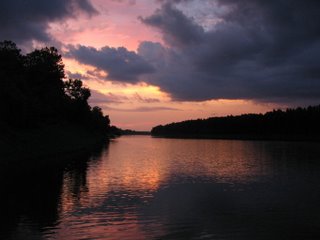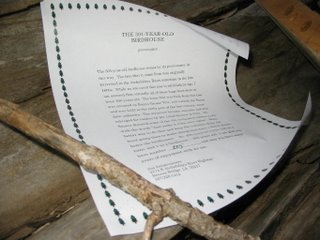Old Birdhouses
 Ever notice all the stumps you see along the bank below the Atchafalaya I10 elevated highway when the water is low? You see them clearly at the Ramah end of the bridge on either side but they are really all along under the twin spans of concrete. Whenever I see them, mostly at this time of year, it always makes me wonder what this swamp looked like when all of those thousands of big trees were still standing in these places where mostly willow and swamp maple and Chinese tallow now shade the ground. I like to imagine I10 with the hundred-foot trees around and right next to the highway, and between the lanes. The whole highway would be densely shaded from one end to the other 17 miles away. It would be like driving at high speed through a forest. Kind of like the aircar chase in the that Star Wars episode, except the road would be straight and not too many vehicles would disintegrate due to driver ineptitude, like the bad guys did chasing Luke Skywalker. But I know building the highway through the trees would never have happened, liability considerations would have dictated that even if the forests were still there, the trees near the highway would have been cut down so as to prevent their falling on the roadway during storms, etc. We pay for insurance in more ways than money; it is always so.
Ever notice all the stumps you see along the bank below the Atchafalaya I10 elevated highway when the water is low? You see them clearly at the Ramah end of the bridge on either side but they are really all along under the twin spans of concrete. Whenever I see them, mostly at this time of year, it always makes me wonder what this swamp looked like when all of those thousands of big trees were still standing in these places where mostly willow and swamp maple and Chinese tallow now shade the ground. I like to imagine I10 with the hundred-foot trees around and right next to the highway, and between the lanes. The whole highway would be densely shaded from one end to the other 17 miles away. It would be like driving at high speed through a forest. Kind of like the aircar chase in the that Star Wars episode, except the road would be straight and not too many vehicles would disintegrate due to driver ineptitude, like the bad guys did chasing Luke Skywalker. But I know building the highway through the trees would never have happened, liability considerations would have dictated that even if the forests were still there, the trees near the highway would have been cut down so as to prevent their falling on the roadway during storms, etc. We pay for insurance in more ways than money; it is always so. But no, we see the big, dark stumps now. All these trees have been recycled (or is that “cycled”) to houses and railroad ties and paneling for the original station wagons and whatever else cheap, durable, beautiful lumber was used for back then. The stumps do serve a purpose. Seeing them, and reflecting on the big trees and the loss of them are the reasons I try to conserve the old wood whenever I get a chance to obtain some. Friends have been generous to me by letting me have the cypress that would otherwise have ended in a burn pile at the demolition/recovery site of a house, barn or other. It always surprises me to see how much wood isn’t considered reusable because it has a ragged end, or is partially split. I take it all and try to do things with it that allow the wood to continue to be seen and used. Which brings us to the reason for the title of this posting (philosophical introductions are usually long-winded, at least mine are).
But no, we see the big, dark stumps now. All these trees have been recycled (or is that “cycled”) to houses and railroad ties and paneling for the original station wagons and whatever else cheap, durable, beautiful lumber was used for back then. The stumps do serve a purpose. Seeing them, and reflecting on the big trees and the loss of them are the reasons I try to conserve the old wood whenever I get a chance to obtain some. Friends have been generous to me by letting me have the cypress that would otherwise have ended in a burn pile at the demolition/recovery site of a house, barn or other. It always surprises me to see how much wood isn’t considered reusable because it has a ragged end, or is partially split. I take it all and try to do things with it that allow the wood to continue to be seen and used. Which brings us to the reason for the title of this posting (philosophical introductions are usually long-winded, at least mine are).A few years ago, Gene Seneca, of Grosse Tete, called and told me to come and get some wood that wasn’t considered useful for construction. I did, and after pulling all the nails, and squaring the ends, I stacked it and thought how I might use it. The idea of birdhouses came to mind. The wood is rough, looks outdoorsy, is very durable, and birdhouses match my limited woodworking skills and tools pretty well. I began making them and numbering each on with a burning tool. A certificate telling the story of the wood came next and is included with each birdhouse. I call them the “301 year-old birdhouses”, for reasons explained on the certificate. I have now made 1
 12 of the little wooden boxes, and each has been given away to someone who values the old wood and has a place in the yard for this artificial cavity for titmice, chickadees or bluebirds to use. I have 11 of them in our yard and they are used every year by bluebirds, chickadees and prothonotary warblers. The latter are common in our woods because we live next to this big river. Some of the boxes have been shipped to Idaho, and others now live in Florida and Indiana and Texas. I don’t know what uses them in those places, but I’ll bet something does. Anyone knowing about scrap cypress that is available for a good cause? Let me know by email (in my profile in Blogger.com) or by comment to this posting. Thanks.
12 of the little wooden boxes, and each has been given away to someone who values the old wood and has a place in the yard for this artificial cavity for titmice, chickadees or bluebirds to use. I have 11 of them in our yard and they are used every year by bluebirds, chickadees and prothonotary warblers. The latter are common in our woods because we live next to this big river. Some of the boxes have been shipped to Idaho, and others now live in Florida and Indiana and Texas. I don’t know what uses them in those places, but I’ll bet something does. Anyone knowing about scrap cypress that is available for a good cause? Let me know by email (in my profile in Blogger.com) or by comment to this posting. Thanks.The river is at 2.6 feet on the Butte La Rose gauge, going to 2.1 by Saturday. The Ohio and Mississippi are a little up and a little down, as is normal for this time of year, more or less, maybe.
Rise and Shine, Jim


2 Comments:
Jim, my wife Brenda received a wooden bird feeder for as a gift last year. Whoever built it went to the trouble of even putting glass plates held by 4 groved corner posts as sides. It WAS a beautiful bird feeder. However, the wood wasn't able to withstand the elements. Seemed like a lot of trouble for someone to have gone through only to have it degraded by the weather. After receiving one of your bird houses earler this year, I knew that the bird feeder builder could most certainly have created a more lasting product had he chosen cypress for the woodstock. I then wondered if you had ever considered making bird feeders with the cypress. Seems like it would be a logical compliment to your houses. I would expect bird feeder patterns to be in abundance. However, you may find that you would probably have a tough time deciding which pattern to use. Anyway, you had asked for ideas.....
Well Randy, I guess it's like it is with that fancy flyfishing gear, most of it is meant to lure fishermen, not fish. Same with bird/yard stuff. If it's pretty people buy it, whether it can stand up to being ourside or not. Making feeders out of old cypress does sound interesting, thanks much. Jim
Post a Comment
<< Home